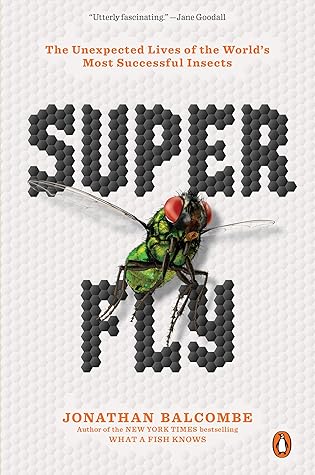Kindle Notes & Highlights
Read between
October 11 - November 10, 2022
plumose (feathery) antennae
The outlandishly long eye-stalks of this male picture-winged fly from Ecuador
Competition for mating rights, typically between males, is widespread in animals,
It appears that male fruit flies are learning and remembering their social standing among other males based on their fight rankings.
It should be mentioned that not all aggression between males is over females; food is another cause.
Females will fight over food, especially if it includes yeast, a valuable commodi...
This highlight has been truncated due to consecutive passage length restrictions.
Ken Preston-Mafham, who has studied these flies in Warwickshire, UK, believes the upper males stay put not because they are deluded in thinking they might succeed with the fly beneath them, but because they are in a better position to pounce onto the next female who alights on the lily.
aedeagus
intromittent
bursa copulatrix is insectese...
This highlight has been truncated due to consecutive passage length restrictions.
Insect genitals come in a remarkable diversity of shapes, sizes, and structures.
promiscuity broadens a female fly’s options for which sperm to assign to her eggs.
“Studies indicate that females can influence paternity by differentially storing sperm from various males in separate sperm storage pouches and controlling which pouch is used for fertilizing eggs.”
how they choose and what qualities of ejaculate they are discriminating a...
This highlight has been truncated due to consecutive passage length restrictions.
Might males be using pleasure to sway females to choose their sperm over that of another male? I haven’t met an entomologist comfortable with such an interpretation, but we should not rule it out.
both sexes of scavenger flies have large genital glands that release an aroma smelling like a mix of lemon and thyme, leading to one suggestion that they instead be called scented flies.
How can scientists see what’s happening on the inside of a pair of fornicating flies? One research team studying five species of tsetse flies used three techniques: (1) they flash-froze mating pairs, then dissected them; (2) they artificially stimulated males; and (3) they viewed copulating pairs with a new X-ray technique that allows events inside the female to be recorded in real time. The scientists admi...
This highlight has been truncated due to consecutive passage length restrictions.
copulatory dialogue.
A study published in 2012 hints that sex might be rewarding for flies
sex-deprived flies will more readily turn to alcohol than will males who have successfully mated.
the sensory experience of copulation also dampens females’ interest in subsequent males—a so-called copulation effect
Oviparity is simply the production and deposition of eggs,
Ovoviviparous flies do what oviparous flies do, with the crucial exception that the larvae emerge from their eggs while still inside the mother,
Viviparity involves the birthing of offspring that develop internally from an egg without a shell-like covering.
tsetse fly, have taken this strategy to its limit, producing in each pregnancy just one larva,
Drosophila melanogaster—“dew-lover with a black belly,”
Fruit flies (technically they are vinegar flies)
Having arrived in the Caribbean via slave ships from Africa and southern Europe, by the 1870s the fruit fly had made its way to New York, Philadelphia, Boston, and other major cities in North America, abetted by a burgeoning post–Civil War trade in rum, sugar, and bananas and other tropical fruits.
nearly 4,000 described species in the megadiverse genus Drosophila
So far, fruit fly research has earned seven Nobel prizes.
There are about a hundred thousand strains of D. melanogaster
amorphous
Marla Sokolowski,
rover/sitter polymorphism
Rovers plow restlessly through their food,
Sitters are more passive, preferring to munch away at food within reach b...
This highlight has been truncated due to consecutive passage length restrictions.
The difference in locomotion between rovers and sitters disappears in the absence of food and is therefore thought to be foraging-related.
The reality is that who we are is influenced by both genes and environments, and furthermore that their effects are codependent. Gene–environment interactions are therefore better characterized as nature through nurture, rather than as nature versus nurture.
phylogeny
Hawaiian fruit fly wing patterns,
leks” (specific locations in the habitat where, like some birds, males engage in contests for females).
“We think Drosophila got to Hawaii about 25 million years ago and they’ve been jumping along this conveyor belt as they go. And every time a new island forms, the flies colonize it and you have a whole new process of speciation taking place in isolation from the neighboring island.”
In the time it takes you to read this sentence, someone somewhere will be killed by a fly-borne disease and hundreds of others will become sick because of fly-associated microorganisms. —STEPHEN A. MARSHALL
Since the year 2000, mosquitoes have accounted for about 2 million human deaths per year, compared with 475,000 per year at the hands of our fellow humans. Researchers have credited mosquitoes with almost half the deaths in human history.
In all, over 15 diseases are transmitted to humans from mosquitoes.
It was not until the 1890s that the connection between mosquitoes and malaria was established.
There are over 200 types of malaria parasite vexing birds, bats, monkeys, antelopes, and lizards worldwide; only five of them afflict Homo sapiens.
Malaria has a historical range much larger than its current one. In addition to the tropics, the disease once stretched as far north as Canada and northern Europe.
When Europeans colonized the Americas, they did so with more than Europeans; they also brought a tidal wave of mosquitoes delivering disease and death against the nonimmune indigenous peoples. Prior to this time, while there were hordes of mosquitoes native to the Americas, they did not carry the lethal diseases that the newly introduced Anopheles and Aedes species did.


